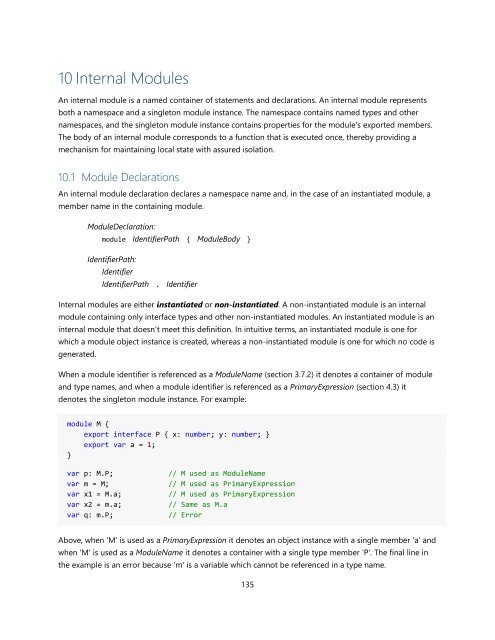TypeScript Language Specification v1.5
TypeScript Language Specification v1.5
TypeScript Language Specification v1.5
You also want an ePaper? Increase the reach of your titles
YUMPU automatically turns print PDFs into web optimized ePapers that Google loves.
10 Internal Modules<br />
An internal module is a named container of statements and declarations. An internal module represents<br />
both a namespace and a singleton module instance. The namespace contains named types and other<br />
namespaces, and the singleton module instance contains properties for the module's exported members.<br />
The body of an internal module corresponds to a function that is executed once, thereby providing a<br />
mechanism for maintaining local state with assured isolation.<br />
10.1 Module Declarations<br />
An internal module declaration declares a namespace name and, in the case of an instantiated module, a<br />
member name in the containing module.<br />
ModuleDeclaration:<br />
module IdentifierPath { ModuleBody }<br />
IdentifierPath:<br />
Identifier<br />
IdentifierPath . Identifier<br />
Internal modules are either instantiated or non-instantiated. A non-instantiated module is an internal<br />
module containing only interface types and other non-instantiated modules. An instantiated module is an<br />
internal module that doesn't meet this definition. In intuitive terms, an instantiated module is one for<br />
which a module object instance is created, whereas a non-instantiated module is one for which no code is<br />
generated.<br />
When a module identifier is referenced as a ModuleName (section 3.7.2) it denotes a container of module<br />
and type names, and when a module identifier is referenced as a PrimaryExpression (section 4.3) it<br />
denotes the singleton module instance. For example:<br />
module M {<br />
export interface P { x: number; y: number; }<br />
export var a = 1;<br />
}<br />
var p: M.P;<br />
var m = M;<br />
var x1 = M.a;<br />
var x2 = m.a;<br />
var q: m.P;<br />
// M used as ModuleName<br />
// M used as PrimaryExpression<br />
// M used as PrimaryExpression<br />
// Same as M.a<br />
// Error<br />
Above, when 'M' is used as a PrimaryExpression it denotes an object instance with a single member 'a' and<br />
when 'M' is used as a ModuleName it denotes a container with a single type member 'P'. The final line in<br />
the example is an error because 'm' is a variable which cannot be referenced in a type name.<br />
135


















